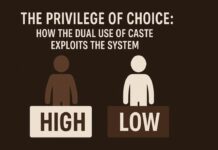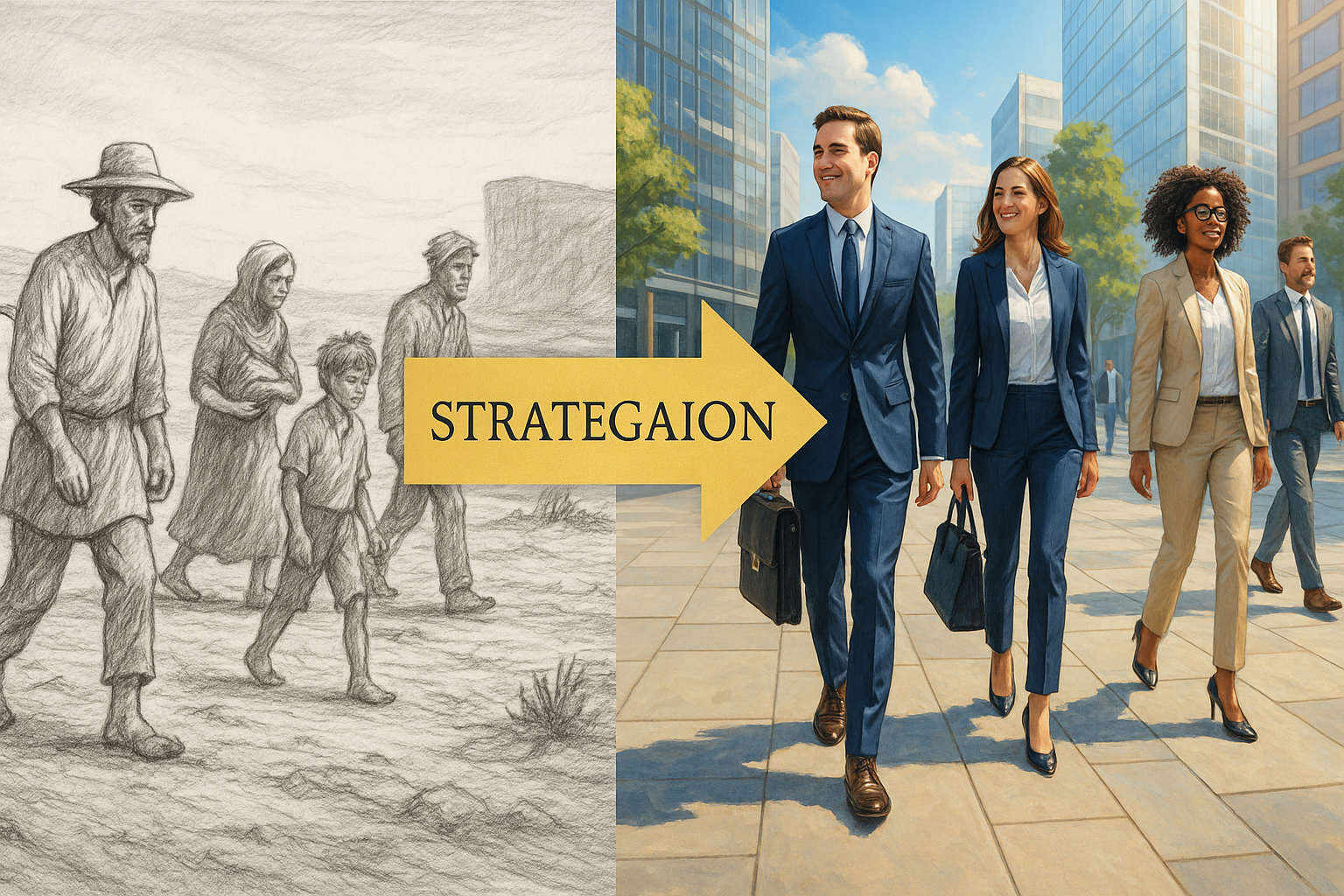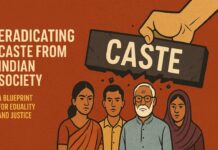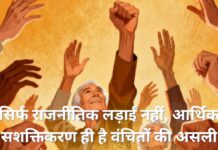From Margins to Metros: Why the Oppressed Must Strategically Migrate for Dignity and Opportunity
Recent documentation reveals the alarming scale of rural violence against Marginalized, Oppressed and Downtrodden communities. Over 60,000 cases of atrocities against Dalits and Tribals are recorded annually, with human rights workers reporting that most cases go unrecorded. The brutality is often shocking in its casual cruelty: a nine-year-old Downtrodden (Dalit) boy beaten to death for drinking water from an “dominant caste” pot, Downtrodden (Dalit) families subjected to complete social boycotts for failing to participate in religious events, women assaulted for attempting to collect water from village wells, and entire communities living under constant threat of violence for the smallest perceived transgression of caste hierarchy. [1][2][3][4][5]
The harsh reality of rural India reveals a disturbing pattern of systematic violence, discrimination, and dehumanization against Marginalized, Oppressed and Downtrodden communities that forces them to flee their ancestral villages in search of basic human dignity. For Marginalized, Oppressed and Downtrodden communities facing inhuman treatment in their home villages—from caste-based violence to social boycotts, from denial of basic services to life-threatening persecution—urban migration represents not merely an economic opportunity but a desperate flight toward survival and dignity. The strategic settlement in cities where similar communities reside, combined with the development of robust cooperative networks, offers these vulnerable populations a pathway from rural persecution to urban empowerment.
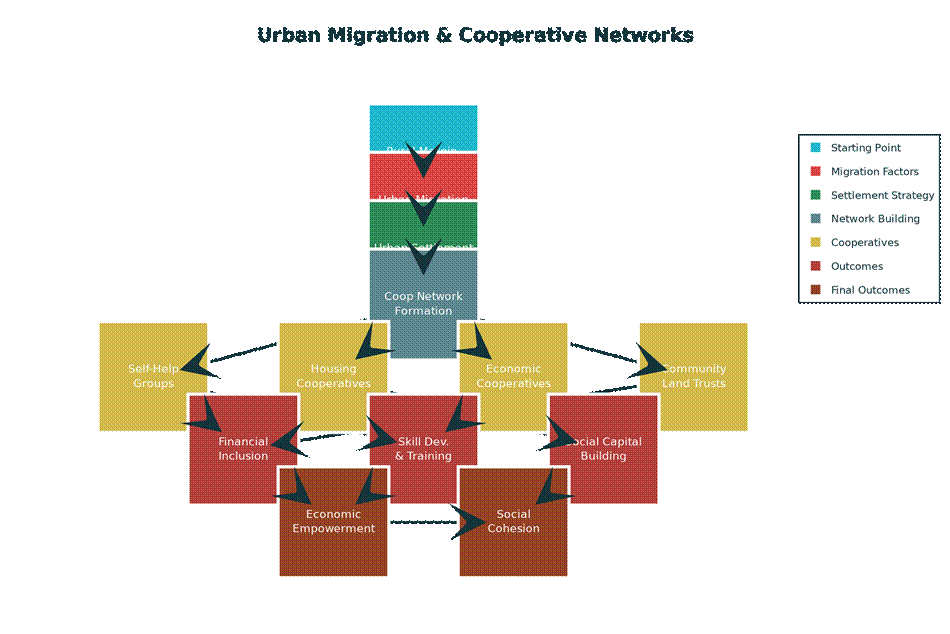
Urban Migration and Cooperative Network Development Pathway for Marginalized Communities
Understanding the Migration Imperative for Marginalized Communities and Reality of Rural Persecution
The Rural-Urban Economic Divide
Rural marginalized communities, particularly those belonging to Scheduled Castes, Scheduled Tribes, and other backward classes, face systemic barriers that limit their economic advancement. The absence of land ownership—a critical asset for rural prosperity—forces these communities to seek alternative pathways to livelihood security. Research indicates that marginalised communities in rural areas experience limited access to productive resources, quality education, and formal employment opportunities, making urban migration an increasingly attractive option for economic survival and advancement.
However, urban migration is not without its complexities. The reservation system, designed to protect and uplift marginalized communities, creates a paradox where mobility between states may result in loss of caste-based benefits and educational opportunities tied to one’s place of origin. This reality necessitates careful strategic planning when considering migration destinations, often favoring movement to nearby urban centers within the same state or region to maintain access to protective policies.
Migration Patterns and Settlement Dynamics
Contemporary research reveals that urban migration patterns among marginalized communities are heavily influenced by the presence of existing social networks and similar community members in destination cities. The tendency to settle in areas where people of similar caste backgrounds reside is not merely a matter of comfort but represents a strategic survival mechanism that provides social capital, economic opportunities, and protection against discrimination.
Studies of major Indian cities demonstrate that residential segregation by caste/tribe persists or worsens in 60 percent of cities, with historically disadvantaged groups concentrated in urban areas with limited access to quality housing, water supply, and sanitation facilities. This segregation, while problematic in some respects, also creates opportunities for concentrated community organization and collective action.
Systematic Violence and Dehumanization
The violence inflicted upon Marginalized, Oppressed and Downtrodden communities in rural areas extends far beyond isolated incidents—it represents a systematic pattern of dehumanization designed to enforce rigid social hierarchies. In villages across India, Downtrodden (Dalit) and other marginalized groups face restrictions that would be unthinkable in any civilized society: prohibition from using village wells, entering temples, sitting at the same level as dominant castes, or even casting shadows on dominant caste individuals. [1][2][4][6]
The Harijan Sevak Sangh survey of 1,155 villages found Untouchables denied access to village wells in 613 villages and barred from temples in 821 villages. These restrictions are enforced through violence so severe that it defies comprehension: forcing Downtrodden (Dalit) to eat feces, parading them naked through streets, burning their homes, and committing sexual assault as punishment for perceived violations of caste protocol. [2][4][5][1]
The 2015 Marukumbi village case in Karnataka exemplifies the coordinated nature of rural oppression. When Downtrodden (Dalit) were denied entry to local barber shops and hotels, 117 people conspired to set fire to Downtrodden (Dalit) huts and assault residents. The case resulted in 101 convictions—believed to be the first instance where such a large number were found guilty in an untouchability-related case. Tragically, Veeresh Marakumbi, a key witness and activist fighting against these atrocities, was found murdered on railway tracks on the very morning he was scheduled to testify in court. [7]
Economic Bondage and Social Exclusion
Beyond physical violence, rural Marginalized, Oppressed and Downtrodden communities face systematic economic exploitation that perpetuates their vulnerability. The Gandhi Peace Foundation’s survey found 2.6 million bonded laborers across 10 states, with 62% being Untouchables and another 25% from tribal communities. These families work for as little as 15-35 rupees per day (US$0.38-0.88) or a few kilograms of rice, trapped in cycles of debt bondage that span generations. [2][4]
The survey revealed that relatives and supporters of legislators and senior bureaucrats were among those employing bonded labor, highlighting the institutional nature of exploitation. Police officers openly admit their reluctance to enforce anti-untouchability laws, with one Tamil Nadu officer quoted as saying: “If we take this law seriously, half the population of Tamil Nadu will have to be arrested. In any case, the police have better things to do than go poking their nose into the private affairs of the people”. [2]
State Complicity and Legal Failures
Perhaps most disheartening is the systematic failure of state institutions to protect Marginalized, Oppressed and Downtrodden communities. 96% of cases of crimes against Downtrodden (Dalit) and 95% of cases against Adivasis remain pending trial, creating a climate of impunity that emboldens perpetrators. In many instances, police officers themselves participate in caste-based violence or refuse to register complaints from marginalized victims. [1][3][4]
The National Crime Records Bureau reports that 68,160 complaints were filed against police in a single year for activities ranging from murder and torture to refusal to file complaints. Of these, 62% were dismissed as unsubstantiated, and only 26 police officers were convicted. This institutional failure leaves Marginalized, Oppressed and Downtrodden communities with no recourse except flight from their home villages. [5]
Cities as Spaces of Liberation and Anonymity
Dr. Ambedkar’s Vision of Urban Sanctuary
Dr. B.R. Ambedkar, the architect of India’s Constitution and champion of Downtrodden (Dalit) rights, recognized that cities offered opportunities for anonymity and escape from the rigid caste hierarchies that defined village life. His vision was grounded in the understanding that urban spaces could dilute traditional social structures and provide marginalized individuals with opportunities to construct new identities based on capability rather than birth. [8][9][10][11]
Ambedkar’s famous critique of villages as “sinks of localism, dens of ignorance, narrow-mindedness” reflected his profound understanding that rural spaces were structurally designed to perpetuate oppression. He viewed urbanization as a strategic move away from caste-dominated village life toward spaces where economic success rather than caste lineage could determine social status. [10][12][13][8]
Contemporary research confirms aspects of Ambedkar’s vision. Urban environments do offer greater anonymity and reduced visibility of traditional caste markers. A Delhi-based study found that urban lifestyles and attire make caste or religious differences particularly difficult to discern through visual markers. This anonymity allows marginalized individuals to escape some of the daily humiliations and restrictions that define rural caste hierarchy. [14][15]
Urban Anonymity and Identity Reconstruction
For marginalized migrants, cities represent spaces where traditional identifications can be challenged and reconstructed. As one study participant noted: “In Delhi, nobody bothers much what you are, so here, all are from outside, having come from here and there, all have got together”. This mixing creates what scholars term “cosmopolitan neighbourliness”—a condition where diverse communities must negotiate differences while maintaining social cohesion. [14][15]
The urban experience allows migrants to distance themselves from village-based oppression while maintaining necessary economic and social connections. Villages become symbolically associated with “sati and untouchability” and “caste, ethnic and religious separation,” while cities provide “possibilities to anonymise the self and challenge the most violent and oppressive forms of difference”. [14]
However, this transformation is neither complete nor unproblematic. Urban anonymity coexists with new forms of discrimination and exclusion. While cities may reduce some forms of caste-based violence, they often create new patterns of residential segregation, employment discrimination, and social exclusion.[8][9][16]
Strategic Settlement: Choosing Community and Location
The Importance of Social Networks in Urban Areas
Research consistently demonstrates that successful urban migration depends heavily on the presence of existing social networks from similar community backgrounds. When marginalized individuals move to cities, they should settle in areas where people from their own caste or regional background are already established. This clustering is not merely a matter of comfort but represents a strategic survival mechanism that provides essential social capital, economic opportunities, and protection against urban discrimination. [14][17][18][19][20][21]
Studies of major Indian cities show that residential segregation by caste often persists or even intensifies in urban areas. While this might initially appear problematic, it actually creates concentrated communities that can organize collectively for mutual support and economic advancement. These settlements serve as “urban villages” that bridge rural origins with urban aspirations. [17][18][19][20][22][23]
The concentration of similar communities creates networks that provide:
- Initial accommodation and orientation to urban life
- Job referrals and employment opportunities within specific sectors
- Access to credit and financial resources through informal lending networks
- Social support during periods of economic hardship or family crisis
- Cultural continuity and identity preservation in alien urban environments
- Collective bargaining power when dealing with urban authorities or employers
Geographic Proximity and Regional Advantages
For marginalized communities contemplating urban migration, strategic selection of nearby urban centers within their home state offers significant advantages over long-distance interstate movement. This approach allows communities to maintain access to state-specific reservation benefits, educational opportunities, and targeted welfare programs while accessing urban economic opportunities. [24][25]
A Delhi-based study found that most slum dwellers come from neighboring states: Uttar Pradesh (48.7%), Rajasthan (17.5%), and Bihar (15%). Of these migrants, 53% belong to Scheduled Castes and Tribes, 21% to Other Backward Castes, and 12% identify as Muslims. This geographic concentration allows migrants to maintain linguistic familiarity, cultural connections, and access to existing social networks while building new urban identities. [14]
The preference for nearby urban areas also facilitates circular migration patterns that allow families to maintain rural connections while building urban capabilities. This reduces migration risks while enabling gradual transition from rural to urban livelihoods. [26][27]
Interstate Migration and Reservation Benefits
A critical consideration for marginalized communities contemplating urban migration is the potential impact on access to reservation benefits and state-specific welfare schemes. India’s reservation system is largely administered at the state level, with variations in policies, quotas, and implementation mechanisms. Interstate migration may result in temporary or permanent loss of access to educational reservations, employment quotas, and targeted welfare programs.
This reality suggests that strategic migration to nearby urban centers within the same state or region may be more beneficial than long-distance interstate movement. Such an approach allows communities to:
- Maintain eligibility for state-specific reservation benefits
- Access urban economic opportunities while retaining rural connections
- Build upon existing linguistic and cultural familiarity
- Utilize established community networks for support and guidance
Building Cooperative Networks: Models for Survival, Economic and Social Empowerment
Self-Help Groups: Foundation for Urban Integration
Self-Help Groups represent the most accessible and immediately beneficial form of cooperative organization for marginalized urban migrants. These small associations of 15-25 members provide critical financial inclusion services that formal banking systems often deny to new urban migrants. For communities fleeing rural persecution, SHGs offer the first secure access to credit, savings facilities, and economic planning resources. These small associations of 15-25 members from similar socioeconomic backgrounds have demonstrated remarkable effectiveness in:
Financial Empowerment: SHGs enable members to pool their savings and access credit at reasonable interest rates, often for the first time in their lives. The collective guaranteed system reduces risk for formal financial institutions while providing members with collateral-free access to capital for income-generating activities.
Skill Development and Entrepreneurship: Many SHGs serve as platforms for business knowledge sharing, skill development, and collaborative entrepreneurship. Members learn from each other’s experiences and often develop complementary businesses that strengthen the local economy.
Social Capital Building: The regular meetings and collective decision-making processes inherent in SHG operations build leadership skills, enhance self-confidence, and create networks of mutual support. For marginalized women in particular, SHGs often represent their first experience with formal organizational participation and democratic governance.
The success of urban SHGs lies in their combination of financial services with social capital building. Regular meetings create networks of mutual support that extend far beyond financial transactions to include childcare cooperation, job information sharing, and collective problem-solving around urban challenges. For women from marginalized communities, SHGs often represent their first experience with formal organizational participation and democratic decision-making. [29][31][28]
The National Urban Livelihoods Mission has demonstrated the scaling potential of SHG-based approaches. Over 7.8 lakh urban SHGs have been formed since 2014-15, with more than 5.36 lakh receiving revolving fund assistance. These groups have facilitated 7.17 lakh loans through bank linkage programs, providing collateral-free credit access that enables business development and asset building. [33][34]
Economic Cooperatives: From Survival to Prosperity
Beyond basic financial inclusion, marginalized urban communities can develop production and service cooperatives that transform their traditional skills into urban economic assets. The Amul model provides a template for how marginalized rural producers can create economic cooperatives that capture value rather than lose it to middlemen and intermediaries. [35][36][37][38][39]
For urban marginalized communities, economic cooperatives might include:
- Handicraft and artisan cooperatives that connect traditional skills to urban luxury markets
- Food processing cooperatives that add value to agricultural products from rural connection areas
- Service cooperatives that organize domestic workers, street vendors, and informal sector participants
- Waste management cooperatives that formalize waste collection and recycling activities
- Construction cooperatives that organize skilled and unskilled labor for urban development projects
The Self-Employed Women’s Association (SEWA) demonstrates how comprehensive cooperative approaches can transform marginalized worker conditions while maintaining democratic governance. SEWA organizes 1.5 million members across agriculture, production, street vending, and services, creating viable democratic cooperatives with strong financial performance and member empowerment.[40][35]
Housing Cooperatives: Securing Urban Shelter
Housing represents the most significant challenge facing marginalized urban migrants, with discrimination in rental markets often forcing families into inadequate informal settlements. Housing cooperatives offer powerful alternatives that provide affordable, secure housing while building community assets. [17][21][41][42]
Collective ownership models allow members to pool resources for land acquisition and construction while maintaining individual occupancy rights. This approach makes homeownership accessible to families who could not independently afford urban housing costs. In successful housing cooperatives, each member owns both their individual unit and a proportional share of underlying land, ensuring they benefit from property appreciation over time. [41][42]
India’s housing cooperative sector includes over 191,955 registered cooperatives supported by 26 Apex Cooperative Housing Federations across states. The National Cooperative Housing Federation provides institutional support for cooperative development, technical assistance, and policy advocacy.[43][44]
Community Land Trusts represent an emerging model with significant potential for marginalized communities. In CLT arrangements, land is held collectively by nonprofit organizations while buildings are individually owned. This removes land from speculative markets while ensuring permanent affordability for community members.[45][46][47][48][49]
Policy Frameworks and Government Support Systems
National Urban Livelihoods Mission and Support Systems
The Government of India has developed comprehensive frameworks specifically designed to support urban marginalized communities through the Deendayal Antyodaya Yojana – National Urban Livelihoods Mission (DAY-NULM). This program targets urban poor households, homeless individuals, and street vendors with interventions designed to build sustainable livelihoods and provide essential social protection.[34][50][51]
The Employment through Skill Training & Placement (EST&P) component has provided skill training to over 13 lakh urban poor since 2014-15, with more than 6.78 lakh trained individuals finding employment. This demonstrates the potential for scaled programs that connect marginalized communities with formal sector opportunities while building their urban economic capabilities. [33][52]
The PM SVANidhi scheme has disbursed over 96 lakh loans totaling ₹13,797 crore to more than 68 lakh street vendors, providing collateral-free working capital that enables business expansion and formalization. The scheme’s emphasis on digital transactions and financial literacy has generated over 557 crore digital transactions worth ₹6.09 lakh crore, demonstrating how targeted support can integrate informal sector workers into formal economic systems. [53]
Comprehensive Social Protection Integration
The SVANidhi se Samriddhi Initiative demonstrates how individual economic empowerment can link to broader social protection systems. Through monthly Lok Kalyan Melas, beneficiaries gain access to eight central government welfare schemes, creating comprehensive support networks that extend beyond immediate economic needs. [53][54]
The new Urban Poverty Alleviation Mission pilot program focuses on six vulnerable occupational groups: construction workers, transportation workers, gig workers, care workers, waste workers, and domestic workers. This occupational approach aligns with the reality of informal sector employment among marginalized urban migrants and provides targeted interventions that address specific community needs. [55]
Challenges and Barriers to Implementation
Continued Urban Discrimination and Segregation
Despite policy frameworks and constitutional protections, marginalized urban communities continue facing systematic discrimination in housing, employment, and social services. Research documents persistent housing discrimination where qualified Downtrodden (Dalit) and Muslim families face rejection based on identity markers rather than economic qualifications. This forces communities into concentrated settlements that may lack adequate infrastructure and services. [9][17][19][21][23]
Employment discrimination persists even in market-driven and technologically advanced sectors. Audit studies reveal how qualified candidates from marginalized backgrounds face hiring rejection based on caste and religious identity rather than merit or capability. This occupational segregation limits economic mobility and perpetuates intergenerational poverty.[19]
The concentration of marginalized communities in specific urban areas, while providing social capital, can also create isolation from broader urban opportunities and services. Geographic segregation may perpetuate poverty and limit social mobility across generations, creating urban versions of rural exclusion.[21][23]
Institutional and Implementation Gaps
Many cooperatives serving marginalized communities face challenges accessing formal financial institutions due to collateral requirements and documentation barriers. Traditional banks often require guarantees and formal papers that newly formed cooperatives cannot provide, limiting their ability to scale operations and serve member needs effectively.[30][56]
Governance and management capacity deficits can undermine cooperative effectiveness without proper training and institutional support. Many cooperatives struggle with financial management, strategic planning, and conflict resolution, requiring ongoing capacity building and technical assistance.[56][30]
Despite comprehensive policy frameworks, implementation often falls short of policy intentions. Bureaucratic delays, corruption, and coordination failures between government levels can limit program effectiveness and reduce actual benefits reaching intended beneficiaries.[55][57]
Success Stories and Transformative Models
Individual Stories of Liberation
The story of Preeti, a Downtrodden (Dalit) woman leader from Bundelkhand, illustrates how strategic urban engagement can create leadership opportunities that would be impossible in rural settings. When 85 Downtrodden (Dalit) migrant families returned to Bijapur during COVID-19 and faced ostracism from dominant castes who refused to allow them village entry, Preeti organized relief efforts that provided health camps, dry rations, and shelter in government schools. [58]
Through her persistent advocacy with local officials and systematic organization of relief efforts, Preeti was able to secure MGNREGA employment for over 87 families, government pensions for 15 senior citizens, and sanitary napkins for 150 girls across three villages. Her success demonstrates how urban-educated marginalized individuals can leverage their capabilities to support rural community members while building sustainable livelihoods. [58]
Urban Anonymity and Professional Success
Research documents how urban environments allow marginalized individuals to construct professional identities that transcend rural caste limitations. Selected stories from Ajay Navaria’s anthology reveal how urban Downtrodden (Dalit) men leverage city anonymity to pursue careers and relationships that would be impossible in rural contexts. The liberty that city anonymity provides enables individuals to develop capabilities and aspirations beyond traditional caste-bound occupations.[15]
A study of Pokhara, Nepal, found that urban Downtrodden (Dalit) communities developed stronger collective identities and more effective advocacy capabilities than their rural counterparts. The urban environment provided opportunities for education, organizational participation, and political engagement that strengthened community capacity for rights assertion and collective action.[59]
Collective Organization and Community Building
Delhi’s squatter settlements demonstrate how marginalized urban migrants can create “cosmopolitan neighbourliness” that bridges diverse community backgrounds. Rather than simply replicating rural social hierarchies, these settlements create new forms of mutual support and cooperation that draw on diverse community strengths.[14]
The mixing of castes, religions, and regional backgrounds in urban slums creates social dynamics that would be impossible in rurally segregated villages. While challenges certainly exist, this diversity also creates opportunities for learning, mutual support, and collective action that can strengthen overall community resilience.[14]
The SEWA Model: Organizing Informal Workers
The Self-Employed Women’s Association (SEWA) provides a powerful example of how comprehensive cooperative approaches can transform the lives of marginalized urban workers. SEWA organizes workers in four categories: agriculture, producers (including ragpickers), street vendors, and service providers. The organization has created viable, democratic cooperatives with good turnover and strengthened the position of 1.5 million members since inception.[2][35]
SEWA’s success demonstrates several key principles:
- Dignity as the foundational principle for all cooperative activities
- Integration of economic empowerment with social security through six specialized organizations
- Democratic governance that ensures member control and participation
- Comprehensive support systems that address health, education, and housing needs alongside economic opportunities
Amul’s Transformation of Rural-Urban Linkages
The Amul cooperative model has transformed the lives of over 3.6 million village milk producers, with more than 70% being small-scale farmers, landless laborers, and members of tribal and scheduled caste communities. The key innovations include:
Three-Tier Cooperative Structure: Village cooperatives collect milk from farmers, district cooperatives process and add value, and the state federation handles marketing and distribution. This structure provides technical and managerial support while maintaining democratic control at each level.
Economic Impact: The cooperative ensures that 80-85% of consumer rupees return to milk producer members, demonstrating how well-organized cooperatives can capture value for their members rather than losing it to middlemen and corporate intermediaries.
Social Transformation: Amul purchases milk exclusively from women, helping to increase their status and provide additional family income. This gender focus has proven essential for both cooperative success and community empowerment.
Urban Housing Cooperative Success Cases
Housing cooperatives have demonstrated significant success in providing affordable urban housing. Mumbai’s century-long experience with cooperative housing societies shows how this model can work at scale. The cooperative structure allows residents to own both their apartments and proportional shares of underlying land, ensuring they benefit from property appreciation while maintaining affordability for future residents.
International examples like the Pilsen Housing Cooperative in Chicago demonstrate how marginalized communities can use cooperative housing to resist gentrification and maintain neighborhood stability. Members pool funds to purchase multi-family buildings, with resale price limitations ensuring continued affordability for low and moderate-income families.
Strategic Recommendations for Community Empowerment
Developing Integrated Migration Strategies
Communities facing rural persecution should prioritize nearby urban destinations within their home states to maintain access to protective policies while accessing urban opportunities. This approach allows families to retain reservation benefits, educational access, and welfare program eligibility while building urban livelihoods and capabilities. [24][25]
Pre-migration planning should include identification of existing social networks, cooperative organizations, and support systems in potential destination cities. Communities can contact organizations like Disha Foundation and other migrant support groups to identify resources and develop settlement strategies before undertaking migration. [27][60]
Circular migration approaches allow families to maintain rural connections while building urban capabilities, reducing risks while enabling gradual transition. This approach provides economic diversification and risk mitigation while allowing families to support rural community members facing ongoing persecution. [26][27]
Building Comprehensive Cooperative Ecosystems
Successful urban integration requires coordinated development of financial, economic, and social cooperatives that address the full range of community needs. Communities should aim for integrated cooperative ecosystems rather than isolated single-purpose organizations that can provide comprehensive support for member empowerment. [22][35]
Progressive scaling from small SHGs to larger economic cooperatives allows communities to build organizational capacity gradually while maintaining democratic governance. The progression from basic savings groups to bank-linked credit access to formal cooperative enterprises demonstrates a proven pathway for sustainable development. [28][30]
Technology integration and digital literacy programs should be core components of cooperative development strategies. Modern cooperatives must leverage digital platforms for marketing, financial management, and customer engagement to compete effectively in urban markets. [61]
Advocacy and Political Participation
Cooperative organizations should engage actively in local political processes to ensure urban development policies support marginalized community interests. This includes participating in city planning processes, advocating for inclusive zoning policies, and supporting candidates who prioritize marginalized community needs. [24][25]
Documentation and reporting of discrimination cases helps build evidence bases for policy advocacy and legal action. Communities should work with organizations like Citizens for Justice and Peace to document cases and pursue legal remedies for discrimination and violence. [1][6]
Coalition building with other marginalized urban communities can strengthen collective advocacy power and resource sharing. The SEWA model demonstrates how organizing across occupational and community boundaries can create more effective advocacy and service delivery.[35]
Conclusion: From Rural Persecution to Urban Empowerment
As India continues to urbanize rapidly, with projections suggesting that urban population will grow from 377 million to 590 million by 2030, the successful integration of marginalized communities through cooperative development represents both a moral imperative and an economic necessity. Cities that embrace and support these community-driven development approaches will benefit from the energy, skills, and entrepreneurship that marginalized and downtrodden communities bring to urban economies. Those that fail to provide such support will face growing problems of urban poverty, social unrest, and economic inefficiency.
For oppressed and downtrodden communities facing inhuman treatment in their rural birthplaces, strategic urban migration combined with cooperative network development offers not merely an escape route but a pathway to dignity, empowerment, and sustainable prosperity. The brutal realities of rural persecution—from casual violence to systematic economic exploitation—make urban migration less a choice than a necessity for survival and human dignity.
The evidence demonstrates that while cities are not panaceas for caste-based discrimination, they do provide crucial opportunities for anonymity, economic diversification, and collective organization that remain impossible in rural contexts. Dr. Ambedkar’s vision of cities as spaces of liberation retains its relevance, even as urban discrimination creates new challenges requiring innovative responses.
The key to successful transformation lies in strategic integration of individual migration decisions with collective empowerment strategies. Communities must leverage urban anonymity and economic opportunities while building cooperative networks that provide mutual support, economic advancement, and political advocacy capabilities. Through Self-Help Groups, housing cooperatives, economic enterprises, and comprehensive social support systems, marginalized urban communities can create sustainable livelihoods that provide dignity and prosperity.
Success requires coordinated action from communities themselves, supportive government policies, and broader social recognition of the contributions these communities make to urban prosperity. Cities that embrace and support community-driven development approaches benefit from the entrepreneurship, skills, and resilience that marginalized communities bring to urban economies. Those that fail to provide such support will face growing problems of urban poverty, social tension, and economic inefficiency.
The pathway from rural persecution to urban empowerment is neither simple nor guaranteed, but it represents the most viable strategy available for communities seeking to escape systematic oppression while building sustainable futures. Through strategic settlement, cooperative organization, and collective action, oppressed communities can indeed transform their conditions and claim their rightful place as equal participants in India’s urban future.
The journey requires courage, planning, and solidarity, but the alternative—continued subjugation to rural violence and dehumanization—makes the risks worthwhile. For those communities trapped in cycles of rural persecution, cities offer not just economic opportunities but the fundamental promise of human dignity and the chance to build lives based on capability rather than birth. This transformation, supported by appropriate cooperative networks and policy frameworks, represents both a personal liberation and a contribution to India’s broader democratic and economic development.
- https://cjp.org.in/the-alarming-rise-of-anti-dalit-violence-and-discrimination-in-india-a-series-of-gruesome-incidents-since-july-2024/
- https://www.culturalsurvival.org/publications/cultural-survival-quarterly/indias-untouchables
- https://www.fairplanet.org/editors-pick/violence-against-marginalised-castes-increases-in-india/
- https://www.hrw.org/reports/1999/india/India994-02.htm
- https://www.nationalgeographic.com/pages/article/indias-untouchables-face-violence-discrimination
- https://www.bbc.com/news/world-asia-india-18394914
- https://timesofindia.indiatimes.com/city/hubballi/landmark-untouchability-conviction-101-found-guilty-in-marakumbi-case/articleshow/114470570.cms
- https://universalinstitutions.com/urbanisation-no-liberating-force-for-dalits/
- https://madrascourier.com/policy/housing-apartheid-in-india-passive-untouchability/
- https://www.theweek.in/theweek/cover/2025/04/12/despite-being-banned-by-the-constitution-untouchability-persists-in-india-across-villages-and-cities.html
- https://www.roundtableindia.co.in/urban-development-policy-in-india-and-exclusion-of-dalit-bahujans/
- https://cnlu.ac.in/wp-content/uploads/2025/05/Law-Caste-and-Urban-Space-A-Critical-Analysis-by-Atharva-Shukla.pdf
- https://pwonlyias.com/mains-answer-writing/analyze-the-impact-of-urbanization-on-the-dalit-community-in-india-discuss-how-despite-b-r-ambedkars-belief-in-the-liberating-potential-of-cities-caste-based-discrimination-continue-to-persist-i-2/
- https://eprints.whiterose.ac.uk/id/eprint/74768/6/dattaa1.pdf
- https://sanglap-journal.in/index.php/sanglap/article/download/266/441/496
- https://article-14.com/post/muslims-dalits-face-the-worst-residential-segregation-discrimination-in-urban-cities-study-confirms-628c3e5162638
- https://www.archdaily.com/983475/urban-disparities-how-caste-shapes-cities
- https://cprindia.org/recasting-inequality-residential-segregation-by-caste/
- https://journals.sagepub.com/doi/full/10.1177/0956247818812330
- https://www.ideasforindia.in/topics/urbanisation/residential-segregation-in-urban-india-and-persistence-of-caste-i.html
- https://compass.rauias.com/current-affairs/caste-urbanisation/
- https://thelaw.institute/co-operation-genesis-principles-values-growth-and-development/empowering-marginalized-role-cooperatives/
- https://iprr.impriindia.com/v2-i2-unveiling-exclusion-exploring-indias-urbanization-experience-effect-on-marginalized-communities/
- https://www.indiawaterportal.org/agriculture/livelihoods/securing-land-rights-deprived-urban-communities
- https://utsynergyjournal.org/2019/06/16/marginalizing-the-marginalized-slum-dwellers-eroding-citizenship-and-land-rights-in-delhi/
- https://www.pib.gov.in/PressReleasePage.aspx?PRID=1906810
- https://openknowledge.worldbank.org/bitstreams/4381bf0a-56fa-5c1a-a15d-7a3df43ae227/download
- https://www.nextias.com/blog/self-help-groups-shgs/
- https://vajiramandravi.com/current-affairs/self-help-groups/
- https://lotusarise.com/self-help-groups-upsc/
- https://www.heifer.org/blog/what-is-a-self-help-group.html
- https://www.drishtiias.com/pdf/self-help-groups-shgs.pdf
- https://www.pib.gov.in/PressReleasePage.aspx?PRID=1884871
- https://nulm.gov.in/PDF/NULM_Mission/NULM_mission_document.pdf
- https://www.socioeco.org/bdf_fiche-document-1749_en.html
- https://ijsi.in/wp-content/uploads/2024/04/18.02.12.20230804.pdf
- https://foodtank.com/news/2013/12/amul-dairy-cooperative/
- https://centeronbusinessandpoverty.com/amul-milk-a-symbol-of-cooperative-success-and-empowered-workers-in-india/
- https://inspirepreneurmagazine.com/amuls-journey-of-innovation-and-community-impact/
- https://assets.kpmg.com/content/dam/kpmg/in/pdf/2018/09/financial-inclusion-marinalization.pdf
- https://idronline.org/article/urban/what-would-it-take-for-low-income-urban-housing-to-succeed/
- https://www.capitalimpact.org/stories/building-stronger-communities-coop-innovation-award/
- https://nchfindia.net/Nov-Dec-2024.pdf
- https://vamnicom.gov.in/uploads/4f51e1ee3035ac8005355277540565be.pdf
- https://www.cltweb.org/resources/what-is-a-community-land-trust/
- https://unhabitat.org/community-land-trusts-affordable-access-to-land-and-housing
- https://worldcltday.org/about-clts/
- https://www.lowimpact.org/categories/economy/community-land-trusts
- https://www.weforum.org/stories/2021/06/community-land-trust-housing-access/
- https://testbook.com/ias-preparation/national-urban-livelihood-mission
- https://mohua.gov.in/upload/uploadfiles/files/18NULM mission document(3).pdf
- https://www.pib.gov.in/PressReleaseIframePage.aspx?PRID=2037057
- https://www.pib.gov.in/PressReleasePage.aspx?PRID=2161157
- https://udd.uk.gov.in/pm-svanidhi/
- https://www.pib.gov.in/PressReleasePage.aspx?PRID=2100337
- https://www.drishtiias.com/daily-updates/daily-news-analysis/cooperatives-and-their-evolution-in-india
- http://rcueslucknow.org/publication/TrainingModules/Dr.A.K.Singh/UPAStrategyPaper.pdf
- https://internationalbudget.org/youth-leaders/
- https://www.sciencedirect.com/science/article/pii/S0016718515301433
- https://dishafoundation.ngo/migrationanddevelopment.html
- https://news.sap.com/india/2022/05/amul-digital-transformation-journey-india/
- https://thesis.eur.nl/pub/10756/
- https://journals.sagepub.com/doi/10.1177/2455328X241245887
- https://www.sciencedirect.com/science/article/abs/pii/S0147596720300858
- https://pmc.ncbi.nlm.nih.gov/articles/PMC8592103/
- https://socialwelfare.vikaspedia.in/viewcontent/social-welfare/women-and-child-development/child-development-1/resources-on-safe-childhood-for-panchayat-members/caste-discrimination?lgn=en
- https://www.authorea.com/users/846220/articles/1234613-the-current-state-of-the-caste-system-in-contemporary-india-persistence-challenges-and-legal-responses
- http://ndl.ethernet.edu.et/bitstream/123456789/35514/1/22.pdf
- https://journals.sagepub.com/doi/10.1177/2455328X251314225?int.sj-abstract.similar-articles.8
- https://arxiv.org/html/2402.03341v1
- https://cpim.org/urban-issues-and-middle-class/
- https://www.sciencedirect.com/science/article/pii/S266618882500440X
- https://timesofindia.indiatimes.com/readersblog/theintersection/unveiling-the-hidden-chains-human-slavery-in-indian-urban-areas-54843/
- https://theimmigrationlab.org/blog/f/outcastes-how-caste-travels-across-borders?blogcategory=campaigns
- https://www.sciencedirect.com/topics/social-sciences/rural-to-urban-migration
- https://journals.openedition.org/samaj/4582
- https://www.frontiersin.org/journals/public-health/articles/10.3389/fpubh.2025.1576285/full
- https://journals.openedition.org/etnografica/4857


